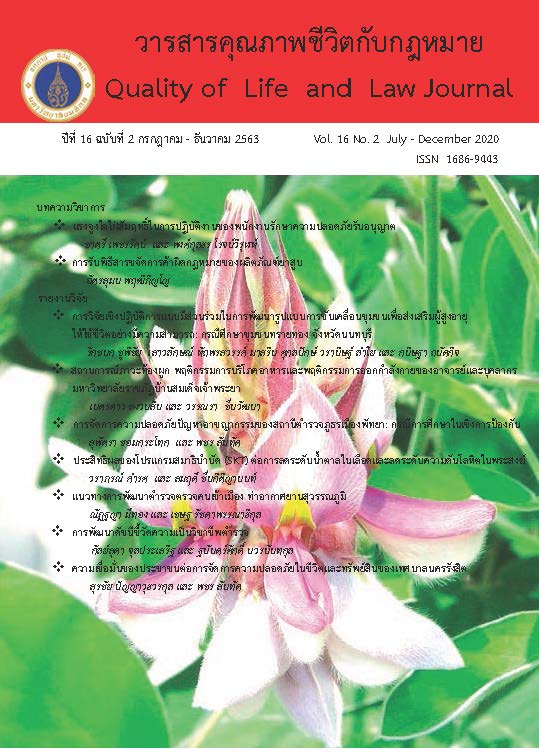Effectiveness of meditation (SKT) therapy to reduce blood sugar and blood pressure in Thai monks
Main Article Content
Abstract
The monks with diabetes and high blood pressure are increasing every year. The monks can maintain good health must exercise appropriate manner. The objective of this study was to determine the effectiveness of a meditation therapy (SKT) intervention to reduce blood sugar and blood pressure in monks. This quasi experimental research involving 38 monks, who were diabetic and hypertensive diseases of temples in Phasicharoen District. A total of 38 diabetic and hypertensive diseases monks were given a 8 week meditation therapy (SKT) and compared their blood glucose and blood pressure levels before and after the program.
The results showed that after 8 weeks of joining the Meditation Therapy (SKT), the results were assessed after the program. The monks had a statistically significant decrease blood glucose (p-value <0.008), the monks had a statistically significant decrease systolic blood pressure (p-value <0.001) and the monks had a significantly significant decrease diastolic blood pressure (p-value <0.001) compared to before entering the Meditation Therapy (SKT) program.
Research recommendations suggest that the implementation of the Meditation Therapy Program (SKT) in the temple to be successful and sustainable, activities should be organized by the health team from the hospital or public health service that oversees the temple area to create confidence, faith and good relationship. And can follow up on the performance of the program regularly.
Article Details
- บทความหรือข้อคิดเห็นใดๆ ในวารสารคุณภาพชีวิตกับกฎหมายเป็
- กองบรรณาธิการไม่สงวนสิทธิ์
References
ณัฐธิดา พระสว่าง, รัชนก คชไกร, ยุพา จิ๋วพัฒนกุล. (2561). ผลของสมาธิบำบัด นั่งผ่อนคลายประสานกายประสานจิตร่วมกับการรักษาแบบเดิมต่อความดันโลหิตในผู้ป่วยความดันโลหิตสูง ชนิดไม่ทราบสาเหตุในหน่วยบริการปฐมภูมิ. วารสารการพยาบาลและการดูแลสุขภาพ, 36(1), 33-42.
นฤมล ปัญญาเลิศ. (2559). สถิติพระสงฆ์ไทยป่วย 5 โรค จากอาหาร วอนคนไทยถวายถูกหลักโภชนาการ. ค้นจาก http://news.thaipbs.or.th/content/254049
พระสุทธิพจน์ สุทฺธิวจโน (สัพโส). (2556). พฤติกรรมสุขภาพของพระภิกษุสงฆ์ในอำเภอพังโคน จังหวัดสกลนคร. (วิทยานิพนธ์ปริญญาพุทธศาสตรมหาบัณฑิต, มหาวิทยาลัยมหาจุฬาลงกรณ์ราชวิทยาลัย).
สนธนา สีฟ้า. (2560). พฤติกรรมการสร้างเสริมสุขภาพของพระภิกษุในจังหวัดปัตตานี. (วิทยานิพนธ์ศึกษาศาสตรมหาบัณฑิต), บัณฑิตวิทยาลัย มหาวิทยาลัยสงขลานครินทร์.
สมพร กันทรดุษฎี เตรียมชัยศรี และคณะ. (2554). สมาธิบำบัดแบบ SKT รักษาสารพัดโรคได้ด้วยตนเอง. กรุงเทพฯ: ปัญญาชนการพิมพ์.
สมาคมความดันโลหิตสูงแห่งประเทศไทย. (2562). แนวทางการรักษาโรคความดันโลหิตสูงในเวชปฏิบัติทั่วไป พ.ศ. 2562. เชียงใหม่: ทริค ธิงค์ การพิมพ์.
สมาคมโรคเบาหวานแห่งประเทศไทยในพระราชูปถัมภ์สมเด็จพระเทพรัตนราชสุดาฯ สยามบรมราชกุมารี. (2560). แนวทางเวชปฏิบัติสำหรับโรคเบาหวาน 2560. (พิมพ์ครั้งที่ 3). ปทุมธานี: บริษัทร่มเย็นมีเดียจำกัด.
สุภาพร แนวบุตร. (2558). ผลของการปฏิบัติเทคนิคสมาธิเพื่อการเยียวยา SKT ต่อระดับความดันโลหิตของผู้ป่วยความดันโลหิตสูงชนิดไม่ทราบสาเหตุ. วารสารการพยาบาลและสุขภาพ, 9(3), 14-22.
ศนิกานต์ ศรีมณี และคณะ. (2556). โครงการวิจัยปัจจัยที่มีความสัมพันธ์ต่อพฤติกรรมการบริโภคของพระภิกษุสงฆ์และพฤติกรรมการถวายภัตตาหารของประชาชนในเขตภาษีเจริญ กรุงเทพมหานคร. กรุงเทพฯ.
อมรรัตน์ แก้วโพนเพ็ก. (2561). ผลของการออกกำลังกายร่วมกับสมาธิบำบัดในผู้สูงอายุกลุ่มติดบ้านที่เป็นโรคเบาหวานชนิดไม่พึ่งอินซูลิน ตำบลวังสวาบ จังหวัดขอนแก่น. วารสารวิชาการมหาวิทยาลัยอีสเทิร์นเอเชีย ฉบับวิทยาศาสตร์และเทคโนโลยี. 12(2), 265-72.
อุบล สุทธิเนียม. (2556). สมาธิบำบัด SKT2 ต่อระดับความดันโลหิตและตัวบ่งชี้ทางเคมี. วารสารวิทยาลัยพยาบาลบรมราชชนนี กรุงเทพ, 29(2), 122-133.
American Diabetes Association. (2017). Comprehensive Medical Evaluation and Assessment of Comorbidities. Diabetes Care. 40 (Suppl. 1): S25–S32 | DOI: 10.2337/dc17-S006.


